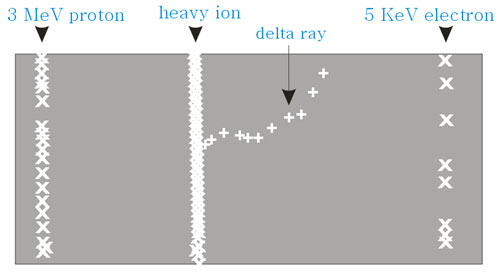Radiobiology > Physical Processes > Linear Energy Transfer [LET] > Linear Energy Transfer [LET] (cont.)
Linear Energy Transfer (LET), continued
![]()
Ionization tracts. When particulate or electromagnetic energy penetrates a cell, one or more ionizations will likely take place. While the precise site of interaction is somewhat random, ionizations will distribute along distinct paths.
The density of ionizations along a given path relates inversely to kinetic energy of the particle or photon.
Thus a decelerating particle produces the greatest number of ionizations just before coming to rest. Comparing particles or photons, it follows also that LET for a gamma ray may be smaller than LET for an x-ray.
 |
|
Simulation of various radiation energies passing through a medium - each hatch mark represents an ionization.
The heavy ion is a very high-LET particle; the delta ray represents secondary electrons with sufficient energy to make a separate ionization tract. The 5 keV electron is the typical energy of a secondary electron produced by X-ray photons used in diagnostic
imaging.
Note that absorption (and attenuation) of a photon beam is related to the atomic number of the impinged mass and inversely related to the energy of the incident photon
beam.
The medium shown is approximately 200 nm in width - a DNA double helix width is about 2
nm.
(Developed after Cox J.D. and Ang K.K., eds. Radiation Oncology Rationale, Technique, Results. 8th edition. St Louis, MO: Mosby, 2003. p44.) |
